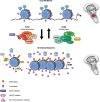Epigenetic Targeted Therapy for Diffuse Intrinsic Pontine Glioma
- PMID: 28592748
- PMCID: PMC5566706
- DOI: 10.2176/nmc.ra.2017-0018
Epigenetic Targeted Therapy for Diffuse Intrinsic Pontine Glioma
Abstract
Diffuse intrinsic pontine glioma (DIPG) is a rare but uniformly fatal cancer of the brain, with peak incidence in children of 5-7 years of age. In contrast to most types of human cancer, there has been no significant improvement in treatment outcomes for patients with DIPG. Since DIPG occurs in the brainstem, a vital region of the brain, there are no surgical options for providing relief to patients, and chemotherapy as well as radiation therapy provide palliative relief at best. To date, more than 250 clinical trials evaluating radiotherapy along with conventional cytotoxic chemotherapy, as well as newer biologic agents, have failed to improve the dismal outcome when compared with palliative radiation alone. The recent discovery of somatic oncogenic histone gene mutations affecting chromatin regulation in DIPG has dramatically improved our understanding of the disease pathogenesis in DIPG, and these findings have stimulated the development of novel therapeutic approaches targeting epigenetic regulators for disease treatment. This review will discuss about the role of histone modification in chromatin machinery and epigenetic therapeutic strategies for the treatment of DIPG.
Keywords: DIPG; demethylation; histone; methylation; pediatric brain tumor.
Conflict of interest statement
The author declares that there is no conflict of interest with the content of this report.
Figures

References
-
- Wong ET, Hess KR, Gleason MJ, et al. : Outcomes and prognostic factors in recurrent glioma patients enrolled onto phase II clinical trials. J Clin Oncol 17: 2572–2578, 1999 - PubMed
-
- Buckner JC: Factors influencing survival in high-grade gliomas. Semin Oncol 30: 10–14, 2003 - PubMed
-
- Freeman CR, Farmer JP: Pediatric brain stem gliomas: a review. Int J Radiat Oncol Biol Phys 40: 265–271, 1998 - PubMed
-
- Berger MS, Edwards MS, LaMasters D, Davis RL, Wilson CB: Pediatric brain stem tumors: radiographic, pathological, and clinical correlations. Neurosurgery 12: 298–302, 1983 - PubMed
Publication types
MeSH terms
Grants and funding
LinkOut - more resources
Full Text Sources
Other Literature Sources

